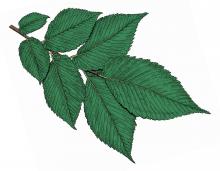Trees, Shrubs and Woody Vines
Media

Species Types
Scientific Name
Celtis occidentalis
Description
Common hackberry is named for its sweet, purple, edible fruits, but most people identify hackberry with its weird-looking bark, which develops numerous corky, wartlike projections and ridges.
Media

Species Types
Scientific Name
Ulmus americana
Description
Until Dutch elm disease came to America, the large, graceful American elm was widely planted along city streets and was beloved as the all-American shade tree. Now large specimens are rare, since the deadly fungus usually kills trees before they reach fine old ages.
Media

Species Types
Scientific Name
Salix spp. (about 12 species in Missouri)
Description
Exotic willows are available at lawn and garden centers, but there are several willow species that are native to Missouri. Most are rather humble colonizers of gravel bars, riverbanks, and lakesides. Many are important for human economic interests. All have a place in our wild ecosystems.
Media

Species Types
Scientific Name
Diospyros virginiana
Description
Persimmon is best known in the fall, when its orange, plumlike fruits come on. Be careful, however, to make sure a persimmon is ripe before you pop it into your mouth, or you could have a puckery surprise!
Media

Species Types
Scientific Name
Maclura pomifera
Description
Osage orange is a densely branched, short-trunked, thorny tree. It bears weird-loooking, softball-sized, chartreuse, brainlike fruits, which often lie beneath the tree in abundance in autumn.
Media

Species Types
Scientific Name
Lonicera japonica
Description
Don’t kid yourself about this invasive, exotic vine: Japanese honeysuckle is an aggressive colonizer that shades out native plants and harms natural communities. Learn how to recognize it!
Media

Species Types
Scientific Name
Parthenocissus quinquefolia
Description
Occasionally confused with poison ivy, Virginia creeper is easily identified by simply noticing that most of its leaflets are in fives, instead of threes. This common native vine is useful in landscaping.
Media

Species Types
Scientific Name
Quercus imbricaria
Description
Shingle oak got its name because the naturalist who discovered it noticed that French colonists in Illinois were using the wood to make roofing shingles. The leaves resemble those of laurel (bay), lacking lobes or teeth — but laurel trees don't bear acorns!
Media

Species Types
Scientific Name
Corylus americana
Description
American hazelnut is a thicket-forming shrub that grows to about 10 feet high. It is prized for its edible nuts, which are covered by a distinctive leafy or papery, jagged-edged bract.
Media

Species Types
Scientific Name
Cornus amomum
Description
Swamp dogwood, or silky dogwood, grows nearly statewide in wet locations. Recognize it by its reddish-brown or dark brown young branchlets and blue, berrylike fruit, conspicuous in late fall.
See Also
About Trees, Shrubs and Woody Vines in Missouri
There are no sharp dividing lines between trees, shrubs, and woody vines, or even between woody and nonwoody plants. “Wood” is a type of tissue made of cellulose and lignin that many plants develop as they mature — whether they are “woody” or not. Trees are woody plants over 13 feet tall with a single trunk. Shrubs are less than 13 feet tall, with multiple stems. Vines require support or else sprawl over the ground.





















